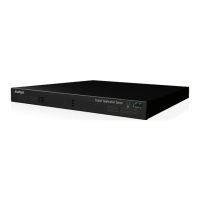network components, including servers like the MCU and Scopia
®
Desktop
server, endpoints like XT Series and other network devices like LDAP
servers and network routers.
Multi-Point A multi-point conference has more than two participants.
Multi-tenant Service provider, or multi-tenant, deployments enable one installation to
manage multiple organizations. All the organizations can reside as tenants
within a single service provider deployment. For example, Scopia
®
Management can manage a separate set of users for each organization,
separate local administrators, separate bandwidth policies etc. all within a
single multi-tenant installation.
Multicast Streaming
Multicast streaming sends a videoconference to multiple viewers across a
range of addresses, reducing network traffic significantly. Scopia
®
Desktop
server multicasts to a single IP address, and streaming clients must tune in
to this IP address to view the meeting. Multicasts require that routers,
switches and other equipment know how to forward multicast traffic.
NAT
A NAT, or Network Address Translation device, translates external IP
addresses to internal addresses housed in a private network. This enables
a collection of devices like endpoints in a private network, each with their
own internal IP address, can be represented publicly by a single, unique IP
address. The NAT translates between public and private addresses,
enabling users toplace calls between public network users and private
network users.
NetSense
NetSense is a proprietary Scopia
®
Solution technology which optimizes the
video quality according to the available bandwidth to minimize packet loss.
As the available bandwidth of a connection varies depending on data traffic,
NetSense's sophisticated algorithm dynamically scans the video stream,
and then reduces or improves the video resolution to maximize quality with
the available bandwidth.
Packet Loss
Packet loss occurs when some of the data transmitted from one endpoint is
not received by the other endpoint. This can be caused by narrow
bandwidth connections or unreliable signal reception on wireless networks.
PaP Video Layout The PaP (Picture and Picture) view shows up to three images of the same
size.
Phantom Power Microphones which use phantom power draw their electrical power from the
same cable as the audio signal. For example, if your microphone is
powered by a single cable, it serves both to power the microphone and
transmit the audio data. Microphones which have two cables, one for sound
and a separate power cable, do not use phantom power.
PiP Video Layout
The PiP (Picture In Picture) view shows a video image in the main screen,
with an additional smaller image overlapping in the corner. Typically, a
Glossary
52 Installing the Avaya Scopia
®
Streaming and Recording Server June 2015
Comments on this document? infodev@avaya.com

